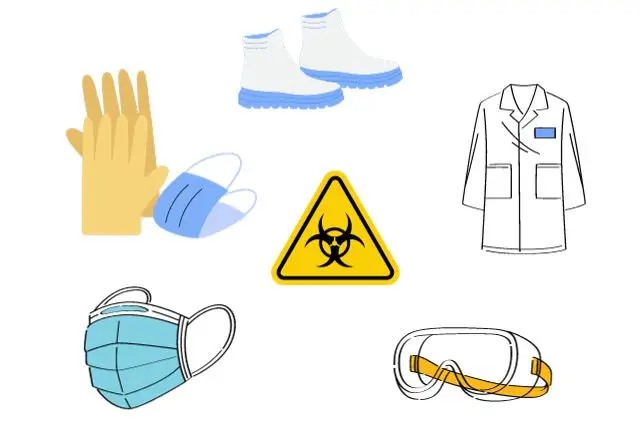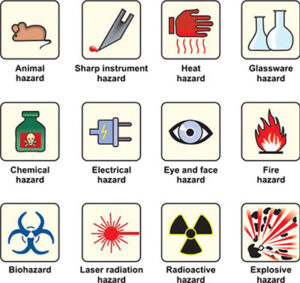
Hazards in Clinical Biochemistry
- Hazards in Clinical biochemistry healthcare mein ek important role play karta hai, jisme biological samples jaise blood, urine, aur tissues ka analysis karke diseases ka diagnose, monitor, aur predict kiya jata hai.
- Yeh process bahut zaroori hai lekin iske saath kuch potential hazards bhi hote hain jo lab staff, patients, aur environment ke liye risk create karte hain.
- Yeh hazards mainly chemical, biological, physical, ergonomic, aur radiation risks ke form mein hote hain, jo sabko manage karna bahut zaroori hota hai.

Chemical Hazards
a. Reagents aur Chemicals ka Use in Clinical Biochemistry
-
Toxic Reagents: Bahut se chemicals jo diagnostic assays mein use hote hain, unhe agar properly handle na kiya jaye toh wo hazardous ho sakte hain. Jaise solvents like chloroform, acetone, methanol, jo agar skin pe lag jaye ya inhale ho jaye toh health ko zarar pohchaa sakte hain. Kuch chemicals like hydrofluoric acid, arsenic-based compounds, aur formaldehyde long-term health problems like neurological disorders ya organ damage ka risk badhate hain.
-
Corrosive aur Irritating Chemicals: Reagents jaise sulfuric acid, hydrochloric acid, sodium hydroxide highly corrosive hote hain aur skin, eyes, aur mucous membranes ko severe burns ya irritation de sakte hain. Agar inko inhale kiya jaye toh respiratory problems bhi ho sakti hain. Protective equipment like acid-resistant gloves aur face shields zaroori hote hain jab in chemicals ka use ho.
-
Carcinogenic Substances: Kuch reagents jaise benzene, formaldehyde, vinyl chloride carcinogenic hote hain. Agar in substances ke saath prolonged exposure hota hai bina protection ke, toh cancer jaise long-term health risks badh jaate hain.
b. Chemical Spills, Leaks, aur Handling
-
Spill Risks: Agar hazardous chemicals laboratory mein spill ho jaye toh wo staff ko toxic ya corrosive substances ke exposure ka risk deti hain. Agar reagent spill mein carcinogenic ya mutagenic compound involved ho, toh contamination pura workspace ko ho sakta hai. Aise cases mein chemical spill ko turant clean karna aur appropriate emergency procedures follow karna zaroori hai.
-
Proper Storage: Chemical storage kaafi important hai jisme incompatible substances ko alag rakha jaye. Flammable chemicals ko oxidizers se alag store karna aur unko well-ventilated, temperature-controlled areas mein rakhna chahiye, taaki unke degradation ya reactions se bach sakein.
c. Waste Disposal aur Chemical Waste Hazards
-
Waste Disposal: Agar chemical waste properly dispose na kiya jaye toh wo environment ko contaminate kar sakta hai. Jaise mercury ya cadmium jaise heavy metals ko agar general waste mein dispose kiya jaye, toh wo ecosystems pe long-lasting toxic effects daal sakte hain. Laboratories ko specialized waste bins aur disposal protocols ka follow karna chahiye.
Biological Hazards
a. Exposure to Infectious Materials
-
Bloodborne Pathogens: Clinical biochemistry mein biological samples jaise blood, serum, plasma aur urine ke saath kaam karte waqt bloodborne pathogens jaise Hepatitis B, Hepatitis C, HIV aur Syphilis ka exposure ho sakta hai. Yeh pathogens needle sticks ya mucous membranes ke contact se transfer ho sakte hain. Dried blood bhi risk create kar sakta hai agar proper precautions na liye jaye.
-
Infection Risk through Aerosolization: Kuch laboratory procedures jaise centrifugation ya sealed vials ka open karna aerosols create kar sakte hain jo infectious particles carry karte hain. Agar yeh aerosols skin pe lagte hain ya inhale ho jate hain, toh infection ka risk hota hai.
b. Laboratory Contamination aur Cross-Contamination
-
Cross-Contamination of Samples: Cross-contamination tab hota hai jab ek biological sample doosre sample ya reagent ke saath mix ho jata hai. Isse inaccurate test results aa sakte hain, jo patient care ke liye critical ho sakte hain. Contaminated equipment, jaise pipettes, test tubes, aur centrifuges easily pathogens transfer kar sakte hain.
-
Handling Biological Samples: Biological samples ko hamesha infectious samajhke treat karna chahiye. Yeh baat un samples ke liye bhi valid hai jo visible nahi lagte. Biosafety cabinets, gloves, face masks aur goggles ka use karke samples ko safely handle karna zaroori hai.
c. Disposal of Biological Waste
-
Waste Disposal: Biohazardous waste, jaise used pipette tips, contaminated gloves, aur blood samples ko proper, leak-proof, aur puncture-resistant containers mein dispose karna zaroori hai. Laboratories ko yeh ensure karna chahiye ki biological waste ko regulated guidelines ke hisaab se dispose kiya jaye taaki contamination na ho.
Physical Hazards
a. Electrical aur Fire Hazards
-
Electrical Safety: Clinical biochemistry laboratories mein kai electrical devices ka use hota hai jaise centrifuges, blood analyzers, aur refrigerators. Agar equipment properly maintain na ho, ya faulty ho, toh electrical shock ka risk hota hai. Wet conditions mein bhi electrical equipment se shock lagne ka risk badhta hai.
-
Fire Hazards: Flammable chemicals, jaise ethanol, acetone, aur organic solvents, ke saath electrical equipment ka use fire risk ko increase karta hai. Laboratories ko fire extinguishers se fully equipped hona chahiye aur fire safety protocols follow karna chahiye. Flammable chemicals ko fire-resistant storage cabinets mein store karna aur ventilation ko maintain karna zaroori hai.
b. Mechanical Hazards
-
Moving Parts: Laboratory equipment, jaise centrifuges aur automatic pipettes, ke moving parts bhi injuries ka cause ban sakte hain. Jaise agar centrifuge balance na ho toh wo violently spin kar sakta hai aur hazardous chemical spills ho sakte hain.
c. Ergonomics aur Musculoskeletal Disorders
-
Repetitive Strain Injuries (RSI): Agar laboratory workers repetitive tasks karte hain jaise pipetting, typing, toh unhe carpal tunnel syndrome, tendonitis, aur dusre musculoskeletal problems ho sakte hain. Ergonomic practices ko adopt karna, adjustable workstations ka use karna, aur regular breaks lena zaroori hai.
Glassware Hazards
a. Glassware Ke Tootne Ki Khatra
-
Tootna: Clinical biochemistry labs mein glassware jaise test tubes, beakers, aur flasks kaafi common hote hain. Yeh easily toot sakte hain agar inhe galat tareeke se handle kiya jaye, jaise high pressure, temperature changes, ya improper storage ke wajah se. Glassware tootne se cuts, abrasions, aur severe injuries ho sakti hain.
-
Prevention: Glassware ko handle karte waqt hamesha carefully use karein. Rubber gloves ka istemal karein taaki grip better ho. Glass items ko secure aur designated areas mein rakhna chahiye taaki accidental breakage na ho.
b. Glassware Se Contamination
-
Contamination Risk: Agar glassware mein koi toxic chemicals ya biological samples hote hain aur wo toot jate hain, toh contamination ka risk badh jata hai. Isse not only exposure badhta hai, balki samples bhi unusable ho sakte hain.
-
Safe Cleanup: Agar glassware toot jaye, toh use broom aur dustpan se clean karein (hand se na uthayein). Broken glass ko puncture-resistant containers mein dispose karein. Gloves aur goggles pehna bohot zaroori hai jab cleanup ho raha ho.
Heat Hazards
a. Laboratory Equipment Se Heat Exposure
-
Heat Sources: Clinical biochemistry labs mein aise equipment hote hain jo high temperatures generate karte hain, jaise ovens, incubators, autoclaves, aur water baths. Agar yeh properly handle na kiya jaye, toh burns aur heat stress ho sakte hain. Jaise incubators jo biological samples ko specific temperatures pe rakhte hain, agar accidental contact ho jaye toh severe burns ho sakte hain.
-
Prevention: Workers ko heat-sensitive equipment ko handle karne ke liye training dena chahiye. Heat-resistant gloves ka use karein jab hot surfaces ko touch kar rahe ho. Equipment pe “Hot Surface” warnings honi chahiye aur burn injuries ke liye emergency procedures ready honi chahiye.
b. Heat Stress Aur Fatigue
-
Laboratory Environment: Agar laboratory mein ventilation sahi nahi hai ya high ambient temperature ho, toh heat stress ho sakta hai. Isse dehydration, dizziness, aur fatigue ho sakte hain. Agar prolonged exposure ho toh heat stroke bhi ho sakta hai.
-
Mitigation: Laboratory ko properly ventilated rakhna zaroori hai aur room temperature ko maintain karna chahiye. Regular breaks lene aur hydration ko promote karna bhi essential hai.
c. Hot Chemicals Se Spills
-
Chemical Spills: Agar hot chemicals ya reagents ka use ho raha ho, jaise molten agar ya hot solvents, toh spills se burns ho sakte hain. Kuch chemicals jab heat kiye jate hain toh wo highly reactive ho jate hain, jo burns aur fires ka risk badhate hain.
-
Safety Procedures: Hot chemicals ko handle karte waqt heat-resistant gloves aur goggles pehna zaroori hai. Spills ki situation mein, correct neutralizing agents ka use karke turant clean-up karna chahiye.
Sharp Hazards
a. Sharp Instruments Se Cuts Aur Punctures
-
Risk of Injury: Sharp instruments, jaise scalpels, needles, syringes, aur lancets, clinical biochemistry mein kaafi use hote hain. Agar accidental puncture ya cut ho jaye, toh injuries ho sakti hain, jo infection, blood loss, aur pain ka sabab ban sakti hain.
-
Prevention: Safety devices like needle safety devices ka use karein aur hamesha gloves pehnein. Sharp objects ko kabhi unattended na chhodein aur proper disposal protocols follow karein.
b. Infection Risk
-
Bloodborne Pathogens: Agar sharp object blood ya bodily fluids ke contact mein aata hai, toh bloodborne diseases like HIV, Hepatitis B, aur Hepatitis C ka risk badhta hai. Yeh sharps ke through easily transfer ho sakte hain agar proper precautions na liye jaye.
-
Handling and Disposal: Sharps ko turant use ke baad puncture-resistant containers mein dispose karna zaroori hai. Training zaroori hai taaki workers sharp instruments ko safely handle karein aur injury se bachein.
c. Sharp Objects Aur Biohazardous Materials
-
Accidental Exposure: Agar sharp instruments biological samples ke saath contact mein aate hain jo hazardous materials (bacteria, viruses, toxins) carry karte hain, toh exposure ho sakta hai.
-
Mitigating the Risk: PPE (Personal Protective Equipment) ka use karein, jaise gloves aur face shields jab sharp instruments ko handle karein. Safe handling aur disposal ka protocol follow karna zaroori hai.
Radiation Hazards
a. Radiation Exposure from Radioactive Materials
-
Radioactive Isotopes: Kuch clinical biochemistry assays mein radioactive isotopes ka use hota hai (jaise iodine-125, carbon-14, phosphorus-32). Radiation exposure se acute health effects ho sakte hain, jaise radiation sickness, aur long-term effects jaise cancer ya genetic mutations ho sakte hain.
-
Safety Protocols: Laboratories ko shielding aur containment systems ka use karna chahiye radiation exposure ko minimize karne ke liye. Staff ko dosimeters wear karne chahiye aur radiation safety protocols strictly follow karne chahiye.
b. Emergency Procedures for Radiation Leaks
-
Radiation Spill Response: Radiation spill ke case mein area ko turant evacuate karna, contaminated zone ko secure karna, aur decontamination procedures follow karna zaroori hai. Radiation emergency kits bhi hone chahiye.
Psychosocial Hazards
a. Stress aur Mental Health Challenges
-
High-Pressure Environment: Clinical biochemistry laboratory mein accuracy aur precision ki bohot zaroorat hoti hai. Yeh stress, anxiety, aur burnout ka reason ban sakte hain. Lab staff ko constant deadlines aur responsibility ki wajah se emotional load hota hai.
-
Mental Health Support: Laboratory staff ke liye mental health resources, jaise counseling services aur stress management workshops provide karna zaroori hai. Healthy work-life balance ko promote karna bhi important hai.
Personal Protective Equipment (PPE) aur Laboratory Safety Protocols
a. Role of PPE
-
Gloves: Pipetting aur hazardous materials ko handle karte waqt gloves ka use karna zaroori hai. Different types of gloves, jaise latex, nitrile, aur PVC, ko select karna chahiye depending on chemicals ya biological materials.
-
Goggles aur Face Shields: Goggles eye protection ke liye use hoti hain aur face shields bhi aerosols ya splashes se face ko protect karti hain.
-
Lab Coats aur Aprons: Lab coats jo chemical-resistant ya flame-resistant material ke bane ho unhe wear karna zaroori hai. Yeh skin ko protect karte hain.
b. Biosafety Cabinets aur Fume Hoods
-
Biosafety Cabinets (BSCs): Inka use infectious samples ko safely handle karne ke liye hota hai. Yeh controlled airflow provide karte hain jo hazardous aerosols ko laboratory se bahar jane se rokta hai.
c. Decontamination Procedures
-
Regular cleaning of work surfaces, equipment, aur disposal of used materials in designated containers is critical to prevent cross-contamination. Laboratories ko decontamination protocol maintain karna chahiye.